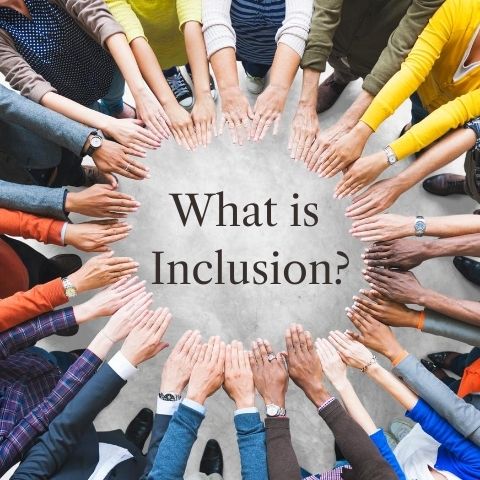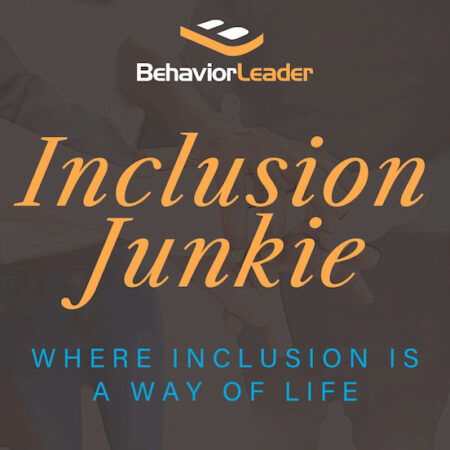Being a leader is difficult and being an inclusive leader is even more challenging for most. We know that there is a strong business case for diversity, but you may have also read articles that state diversity is not the key to success. Why are there so many discrepancies?
 The reason that the research on diversity is so divided is that they are missing the key element: inclusion. Inclusion is the set of behaviors that bring people together, allow them to show up as their authentic selves, and build belonging within an organization. Without inclusion, diversity is harmful. Organizations that simply increase the level of differences between their employees fail because they do not specifically target the discrimination, microaggressions, exclusionary policies and procedures, or every day behaviors of their employees. Creating diverse organizations starts within by creating inclusive environments. Unfortunately, leaders cannot decide one day that it is time to be more inclusive, set a new policy or value for the organization and expect everything to change. Leaders must identify the specific behaviors that need to be changed as well as the ones they want their employees to do instead. If this wasn’t hard enough, once these are identified, leaders must find ways to change the behaviors and develop inclusive habits among their staff.
The reason that the research on diversity is so divided is that they are missing the key element: inclusion. Inclusion is the set of behaviors that bring people together, allow them to show up as their authentic selves, and build belonging within an organization. Without inclusion, diversity is harmful. Organizations that simply increase the level of differences between their employees fail because they do not specifically target the discrimination, microaggressions, exclusionary policies and procedures, or every day behaviors of their employees. Creating diverse organizations starts within by creating inclusive environments. Unfortunately, leaders cannot decide one day that it is time to be more inclusive, set a new policy or value for the organization and expect everything to change. Leaders must identify the specific behaviors that need to be changed as well as the ones they want their employees to do instead. If this wasn’t hard enough, once these are identified, leaders must find ways to change the behaviors and develop inclusive habits among their staff.
Becoming an inclusive environment starts with the leader becoming an inclusive leader. There are five core behaviors of inclusion that leaders can master that will bring their organizations forward.
Education
Leaders never stop learning. There is always so much to learn and leaders have an appreciation for their never-ending learning as well as that of their team’s. They understand that they must not only be experts in their field, but also in the policies and procedures of their organization. Strong leaders also understand their company’s organizational structure, performance management systems, and new technologies. The best leaders add knowledge of relevant issues and events both within their field as well as outside of it, as these events may influence the production, mood, and behaviors of their team.
But education doesn’t stop with consumption of new information. Leaders understand that educating themselves is just as important as educating their team. They pass on new information readily and freely and create systems that allow each person on the team to share new and relevant information with one another.
Ethics & Values
Values are the basic and fundamental beliefs that guide behavior. Ethics are a set of value-based principles that govern behavior. Together, ethics and values motivate, build, and maintain behavior. In other words, values and ethics set the culture. But ethics and values are not just words written on a website or in a policy manual. They are reflected in your behavior – the things you do and say.
Take the following example. Wacky Widgets is a manufacturing plant. The owner of the plant wanted to ensure that Wacky Widgets was a fun place to work and provided the best product possible to consumers. Thus, the values of fun, high quality, consumer focused, and integrity were chosen as the company’s values. The leader of Wacky Widgets; however, is focused on making as many profits as possible. As a result, he constantly asks how many widgets were produced and sold each day. He often walks down to the factory line from his office and yells at employees if they are not assembling widgets fast enough. If there is ever an issue with a widget, he personally inspects it to determine if it is “good enough” to sell, which most often results in him justifying why it can be sold. He is known for saying things like “a bad widget sold is better than a good one sitting” or “customers don’t often ask for refunds; they’ll accept what we give”. This leader is also known for playing favorites. He often chooses someone to take under his wing and joke around with, often putting other employees down as part of this joking. He has been overheard threatening to fire employees for the slightest mistake or for offering a suggestion that goes against his decisions. The only time he seems to be happy is when an employee broke a record for the most sales or is telling him how great of a boss he is.
What do you think this leader’s values and ethics are? What is driving his behavior? What motivates him the most?
In this example, it doesn’t matter what values and ethics the organization has adopted; the leader has set a different culture. Ethical decision-making must be at the heart of every organization for long-term success. But it can’t stop there. Leaders must value others and their different strengths, perspectives, and skills in order to build teams that are innovative, build better products, and provide better services to consumers.
When considering ethics and values, it is important to ensure the organization not only focuses on the right things, but also has a system in place to ensure the chosen values and ethics are actually carried out by the leaders and employees of the organization.
Communication
“The single biggest problem in communication is the illusion that it has taken place” – George Bernard Shaw
Miscommunication can lead to decreased productivity and increased errors. It can also result in hurt or disgruntled feelings. Effective communication eliminates the likeliness that messages are misinterpreted or missed altogether. However, effective inclusive communication ensures not only that the right message is received, but also eliminates the hurt or disgruntled feelings. Inclusive communication considers the other person’s perspective and focuses on bringing people together.
There are a few things that effective inclusive communicators do:
- They listen first.
- They check for understanding.
- They are mindful of their language and words.
- They have high say-do correspondence (they do what they say and say what they do).
Management
Our behavior is shaped by our environment. The things that we do and say are greatly influenced by everything happening both around us and inside of us. If you have a headache, the pain you are feeling might make it more likely you will put your head down, take an aspirin, or snap at someone asking the same question for the tenth time in a row. If the room is warm and it is right after you ate lunch, chances are you will feel more tired, leading to less responding during a workshop. Leaders understand how the environment influences their behavior and take steps to create an environment that promotes the behaviors they want to display.
Effective leaders are always examining their own behaviors and how the environment may influence them and then making changes to constantly improve. While leaders can examine multiple areas and factors, there are four that must be evaluated:
- Awareness: Leaders are aware of their own behaviors. They take time to observe themselves in meetings, interactions with others, and while completing tasks. They take note when they are at their best and when they are at their worst. They are aware of their limits and who they can turn to for help.
- Time: Leaders plan their days to maximize their productivity. They know when they are at their best and schedule important tasks or meetings during those times. They schedule blocks of time after meetings and appointments to allow for completion of quick follow up items, scheduling and planning for longer tasks, and to simply take a break and breathe. They use various tools (calendar, planner, reminders, alarms, etc.) to help keep them on track and write out ideas and task items to ensure their minds are free from distraction when working on important projects.
- Organization: Leaders have an organizational system that allows them to easily access the things they need and help increase efficiency. Whether it is technology to kill distractions while working or a filing system with labels that make it easy to find important documents, leaders have the things they need at their fingertips and know how to easily access the items they need to get the job done.
- Communication: Leaders take control of their communication by ensuring they communicate frequently and openly while also creating boundaries during the times that independent work needs to be completed. They also understand the effectiveness of different modalities of communication and take steps to ensure the messages they send are the same messages that others receive.
Inclusion
Inclusion is the set of things you do and say that result in others being a part of a group. Inclusive leaders don’t assume that others will be welcomed in, encouraged to share their ideas, and valued. Instead, they take steps to ensure they model the behaviors they want others in the organization to demonstrate. They greet employees and take time to learn important information about them. They ask for feedback regularly and create times for every idea to be shared. Most importantly inclusive leaders create safe workspaces for every individual in the organization. Here are five ways a leader can create an inclusive environment:
- Encourage people to disagree with you
- Listen before responding and state what you heard in your own words
- Give equal opportunities for everyone to make decisions as appropriate for their skills
- Conduct round robins during meetings to ensure every voice is heard
- Implement and follow up on feedback you receive from team members
Inclusive leadership is an advanced skill set that every leader should develop to create innovation and long-term success within their organization. Positive organizational culture is set by the leader, and with careful planning and deliberate effort, they can create workplaces where each employee is excited to come to work, share their ideas and innovations, and work hard to complete the organization’s goals.




